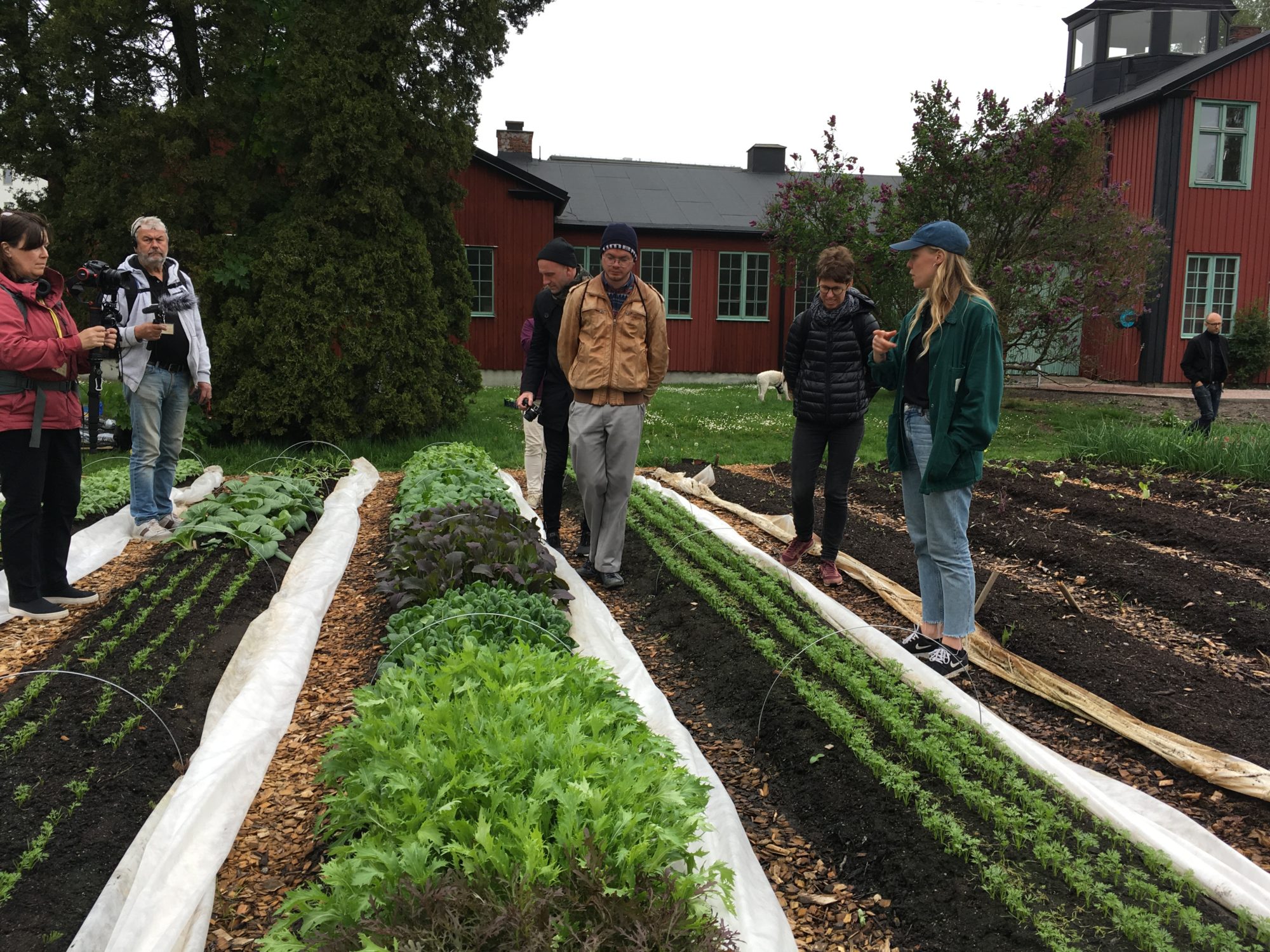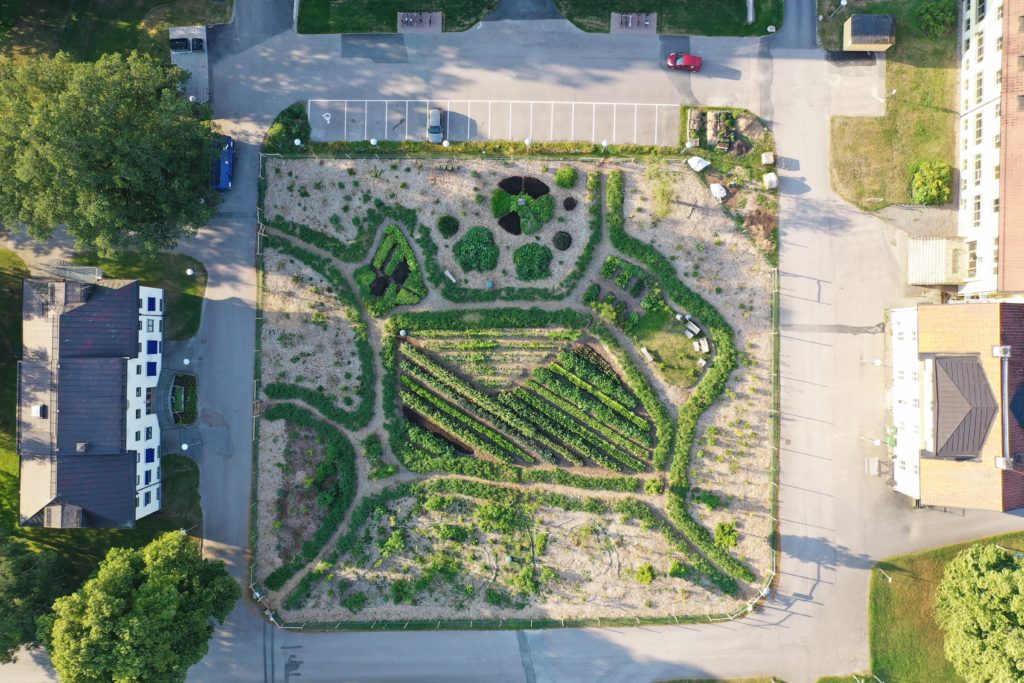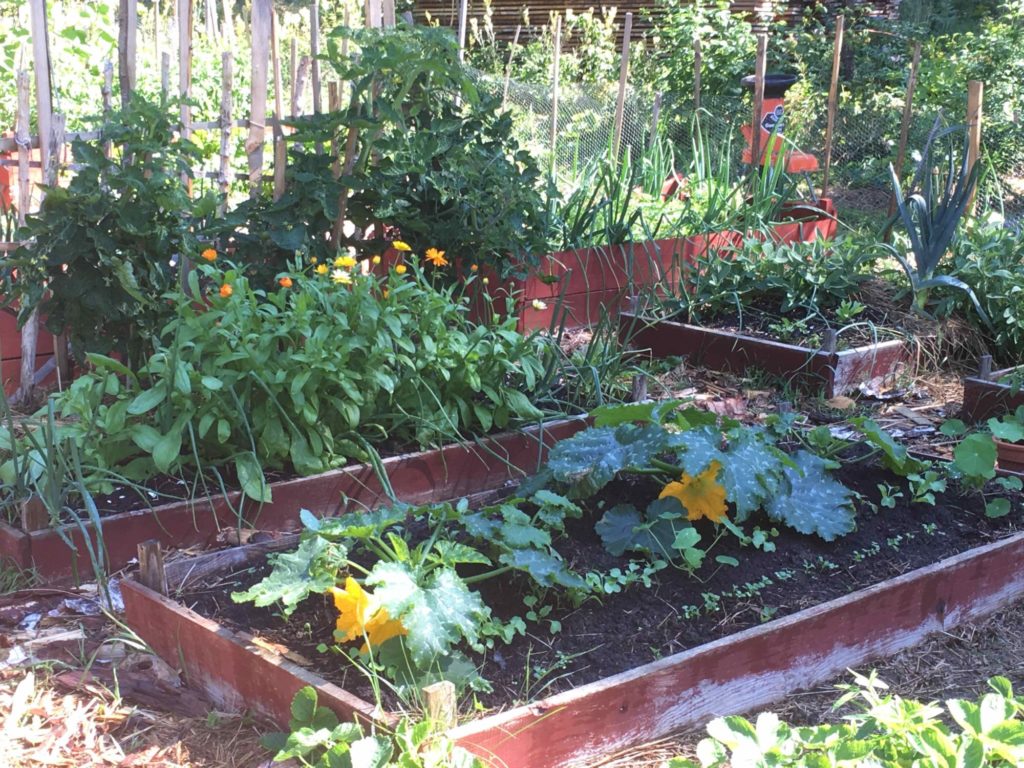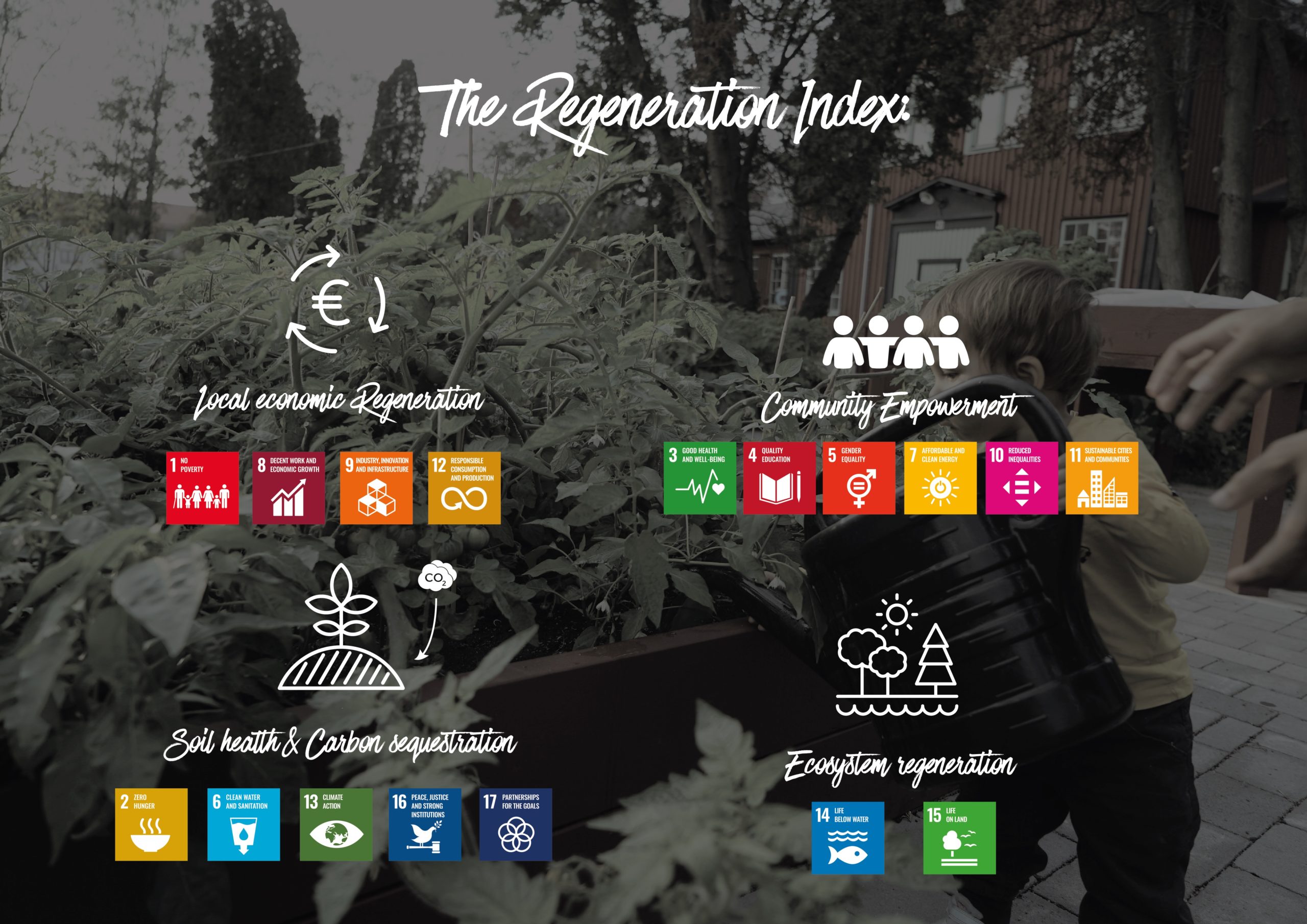
Your garden matters – for biodiversity and climate adaptation
Today, May 22, is Biodiversity Day. So to celebrate the day today we thought we’d talk about how you and I can create our own diversity gardens that also combat climate change and make us more resilient to the extreme weather we’ll be expecting in say 50 years. How can we adapt our cities, villages and communities to a changing climate? Imagine it’s May 2073 and it’s been 30 degrees now and drought for weeks, not a drop of rain. However, some cities have adapted but not all. What does this future city and countryside look like? And what can we expect with 3-4 degrees higher temperatures on average in Sweden – maybe even higher if we don’t manage to keep global warming below 2 degrees? In this blog post, Jonathan tells what he takes away from the basic course and gives 5 solid tips on how you can cultivate for increased biodiversity. How to build a climate-smart diversity garden simply!
(The picture above is from a Urban Farming Safari we arranged on Biodiversity Day a couple of years ago)

Ultuna’s food park – picture from Ultuna Pemakultur on their cultivation at the SLU Campus in Ultuna – A good example of a climate-smart diversity garden where many of the tips we share below have been used as a starting point. Read more here
Climate change and biodiversity
Did you know that we in Sweden can count on 3-4 degrees higher temperatures on average – even if global warming is limited to 2 degrees? What does this mean and what can we do? Jonathan was recently on SMHI’s basic course on climate adaptation and there the message was clear. More greenery and “nature-based solutions” – such as cultivation, green roofs and carbon storage in agricultural land are all ways to both counteract the loss of biodiversity and adapt to a changing climate with extreme rains and droughts, heat waves, etc. The fact is that biodiversity and climate adaptation are very much connected – both in terms of the challenges and the solutions. And your cultivation, whether you cultivate in the city or in the countryside, is an important part of the solution for increased biodiversity and resistance to heat, drought and torrential rain – yes, even a carbon sink that can prevent climate change.

Slaktarens trädgård – The butcher’s garden – a farm on the former asphalt “dessert” close to Gamlestads torg (in central Gothenburg) that adds both biological diversity and increased climate adaptation with better management of rain, drought and heat in the city.. Read more here.
Three things I take with me from the course in Climate adaption
- Sweden’s climate will be much warmer than the global climate (if the global temperature increases by 2 degrees, it increases by 3 degrees or in some areas even 4 degrees in the northernmost part of Sweden)
- Climate adaptation and climate mitigation (adapting to and preventing climate change) must go hand in hand. It is not enough to just reduce emissions, if we stop emitting tomorrow, we need to continue adapting society to a warmer climate for the next hundred years. This adaptation takes time so we need to start now.
- The solutions that are most cost-effective are natural solutions such as greenery and nature-based solutions that fulfill many functions. It will not help to build walls around cities that are at risk of flooding, these will have to be replaced in time and the city may still have to be moved in the end.
Biodiversity day – 22 Maj
Let’s celebrate all gardens!
A lot of research has shown that gardens in and around cities and urban areas contribute a lot to higher biodiversity. A lawn and “ordinary park” comparatively does not have as much diversity as a garden plot or plot with flowers, trees, shrubs and crops. In addition, a vegetable farm or forest horticulture can create a net carbon sequestration if done correctly. Something that both strengthens life and diversity in the earth, and also contributes to slowing climate change at the same time as we adapt to a climate with more drought and torrential rain. More carbon in the soil means more humus which holds more water in both dry and wet periods and thus reduces the risk of flooding and drought (which are often linked and due to poor marine filtration and absorption in the soil). Building soil, loamy soil, is thus an important part of the solution to how we adapt our societies to a warmer climate – and we get higher diversity and carbon storage at the same time. Personally, I would like to see a shift to regenerative agriculture on large areas in Sweden, but apart from this, even the small patch has a great significance.
[Abbreviated quote from Swedish gardening profile John Taylor during the spring in an interview on SVT’s program Sverige (April 14).]“Gardening as a social engine in society is gigantic. There are millions of people who garden and yet it is considered a small hobby. We are responsible for food production, landscape care and a greater part of the biological diversity in society”
How to build a “climate smart” biodiversity garden:
Here are 5 tips from Jonathan – architect and community planner with specialization in cultivation and food production,
- Start digging where you stand:
Do you own a piece of land? Think about what you want with the surface. Perhaps you can invite more people to create your or someone else’s dream garden. Share farmable land on Grow Here if you want to find growers to take care of all or part of the garden or list an existing farm or garden if you are looking for someone who can help and be part of your garden dream or your cultivation initiative.
If you don’t own a piece of land/garden… Search among available cultivation areas and cultivations on Grow-Here.com/discover or ask the neighbor or the municipality, the BRF or those who take care of the green areas near you where you would like to grow. You don’t have to own the land to farm here, often the owners are happy if it is put to better use and can also have higher diversity, aesthetic values and withstand extreme weather better.
- Cultivate the soil, then the plants also thrive
It all starts with a healthy soil with a lot of soil (humus) which consists of 50% carbon, which can hold 20 times its weight in water and thus makes your garden able to withstand both drought and extreme rain. In addition, the humus content increases the food for all life in the soil, which provides food for all plants – which provides food for us. So build a healthy and humus-rich top soil and the plants will thrive in return. Regardless of whether you have sandy or clay soil, it will be “better” with more organic matter (mulch).
You can read more about how to convert grass into cultivation without digging here
- Grow the things you eat, things you enjoy – and what likes to grow there
– Grow what you eat – which vegetables, herbs, berries/fruits and perhaps perennials you don’t have to sow every year.
– Flowers you like to pick that can attract beneficial animals and look beautiful.
– Shrubs and trees that can provide fruit, flowers and both food/habitat for wild animals/insects.
– Co-planting: Dare to mix and combine edible and beautiful, and take advantage of the benefits of co-planting. More on that in this premium article. - Cultivate smart: Serial cultivation, pre-cultivation
– Serial gardening means that you use all free surfaces in time and space and pre-cultivate what you intended to plant so that it is ready just in time for the surface to become empty. A good tip is to make a cultivation plan to know what you need and when to fill all the gaps in the cultivation over the season.
More on that in our premium article on how to become self-sufficient in vegetables.– Pre-cultivate if you grow edible annual crops – get tips on when you grow what in our growing calendar for April and May.
You can also read more about cultivation in our previous blog post about cultivation indoors and outdoors. - Last but not least – Enjoy and dare to be lazy!
– Dare to be a lazy worm in the garden and don’t create more work for yourself than necessary. Lay down in the hammock or on the lawn and take in everything that happens. Notice how clever nature is at solving things you yourself thought you needed to solve.
– Enjoy observing what works well in which places and invest in what you get the most out of around what means something to you. Maybe it’s food, maybe a beautiful place, maybe just a chore that relaxes you.We have made a series of videos where we share more cultivation tips in brief with a small challenge you can try yourself. Here you can e.g. learn more about pre-cultivation, solar studies for vegetable garden placement, green fertilization, interplanting and much more. See the playlist on youtube and the first video via the link below:
I wish you all a nice spring and summer in the unusual May heat and good luck with your farming and gardening dreams and goals for this season!
Sunny greetings,
Jonathan Naraine
Architect, grower and food system designer
Co-founder, Grow Here platform
Planning architect, Skara municipality

Carbon positive food regions: Part 1 – Co-creating our future
Välkomna till en spännande resa mot en regenerativ framtid! I detta blogginlägg utforskar vi möjligheten att skapa kolinlagrande matregioner, där regenerativt jordbruk kan vara svaret på en rad akuta hållbarhetsutmaningar. Vi diskuterar även hur vi genom medvetna val i vår kost kan forma landskapet och främja positiva avtryck genom maten vi äter. Lär dig hur verktygen Holistic management och Keyline Design kan vägleda oss. Tillsammans kan vi skapa en bättre värld för alla varelser som bor på planeten – båda nuvarande och framtida generationer!
CARBON POSITIVE FOOD REGIONS – and how we can co-create them
Could “Västra Götalandsregionen” (the administrative region of West Sweden) become the first to target regional net carbon sequestration in soil by supporting regenerative agriculture? Or Maybe Orust Municipality, where I do a case study in my thesis?
Regenerative agriculture could be a solution to many, if not most, of our current urgent sustainability challenges. It could regenerative our soils and ecosystems while also producing healthy food, improve biodiversity, water infiltration rates, bringing people together and creating new jobs. What if we could facilitate regenerative land use on a regional scale and thus regenerating ecosystems, communities and local economies in the region – improving quality of life for all beings? Human, non-human, present and future generations.
POSITIVE FOODPRINTS:
We design and plan our cities and regional infrastructure like roads, housing areas, water pipes etc – may we through a collaborative food system design approach also design and plan our landscapes to facilitate regenerative land use and food production? What role does physical planners have and how can we encourage bottom up initiatives led by farmers, land owners and consumers? These are some questions I explore in my Master thesis at Chalmers School of Architecture. The challenge is not not create more damage than good with tools of top down planning by finding a good balance of bottom up and top down initiatives.
The daily choices of what people eat, could itself be seen as an act of “food system design” – impacting our common landscapes for the better or for worse. By voting with our forks on regenerative land use we can create “Positive Foodprints”!
What if we could design landscapes by the very act of eating? This is what I call “Positive Foodprints”! Designing our food system can be done by making more conscious acts of eating and having a closer relation to the land and the farmer who manages it – step by step shifting the outcome of that management to land regeneration! In fact the whole design process is based on a collaborative “food system design” carried out by the daily actions of what people eat and how it shapes the landscapes around them.
DESIGNING FOOD SYSTEMS
Om min masteravhandling: Koldioxidpositiva matregioner
About my Master Thesis: Carbon positive food regions “Carbon positive food regions”, as my thesis is called, is an attempt to create a framework, method and give an example of a regenerative regional strategy – exploring opportunities of planning for regenerative agriculture with net negative emissions on regional scale – land use that also produces local food, regenerates land, ecosystems, local communities & local economies. The project is inspired by the movement of regenerative agriculture and the many stories of such farmers. In Sweden. The design research will be situated in the context of a 450 hectare farm called Bjällansås in Uddevalla – exploring its potential as a model of regenerative land use that can be scaled up regionally to build topsoil and heal ecosystems.
Follow my process
Through a series of video-blogs I will share my insights and thoughts throughout the project. The first video I recorded in Swedish is published below:
Episode 1 = Mussel farming
Did you know that 1 ton of mussels can filter 100kg of nitrogen and 10kg of phosphorus?
The first episode in a new video series where I tell about everything from aquaculture that revitalizes ecosystems in the water to regenerative agriculture that builds up food soil and revitalizes ecosystems on land. Firstly I visit a mussel farm that can filter and absorb excess nutrient in the ocean and actively reverse negative trends of eutrophication – regenerating the water ecosystems as they grow and are harvested. The video series is also an exploration of whether we can create a regenerative carbon-sequestering food system in a region or municipality, which I investigate in my master thesis in Architecture and Planning at Chalmers Technical University.
Episode 2 – Regenerative agriculture at Bjällansås farm
At Bjällansås farm Jan Karlsson have been a pioneer in organic and regenerative agriculture and on mostly rented land they are grazing 500 livestock in a way that regenerates the land. The methods of Backcasting and Scenario planning will be used – exploring two future scenarios of carbon positive regions and how they are both shaping and being shaped by the smaller scale developments of local regenerative farms like Bjällansås. The results will be a design proposal showcasing such a future from the farm scale and up to the regional scale seeing, also pinpoint key projects and strategies that actors such as the region, municipality, farmers & land owners can take to get here.
Below is part 2 in this video series where I visit the regenerativa farm Bjällansås att Bokenäset in Uddevalla kommun (video in Swedish).
More will come up (including some in English) so please follow our channel: https://www.youtube.com/c/GrowHere/
What does regenerative mean?
This is worth diving more into and during my Master program – Design and Planning Beyond Sustainable development at Chalmers – I created this Regenerative Index (which is still work in progress) to summarize for me all the dimensions that we need to include as design criteria when we plan and design. Considering its impact for all beings, current and future generations. It is not simply about soil health and carbon sequestration (or planetary health), it’s about building thriving communities and regenerating our collective human health, our local economies and the health of our water and land ecosystems. This subsumes all of the Agenda 2030 SDG’s into a regenerative paradigm of what we need to strive towards, beyond sustainability – towards regeneration!
Holistic management – förvaltning även för kommande generationer
Hur definierar vi regenerativt lantbruk och regenerativa samhällen? Allan Savory har mycket bra att säga om detta.
“No agriculture can be truly regenerative unless it is an agriculture covering all of our Earth’s surface that is managed holistically” Allan Savory (2020)
Managing complex social and ecological systems is crucial to – if we are to find solutions to reverse climate change, biodiversity loss (or even the 6th mass extinction) etc, requires a new framework for management and decision making. Most of the challenges we face today are too complex to solve using our reductionist management methods. In this regard we can look towards Holistic Management as an excellent management framework for defining “the wholes” what we manage, who makes decisions and what a more “holistic context” looks like for individuals and organisations.
Navigating Complexity: Holistic Management for a flourishing future
Managing Earth’s intricate systems requires new approaches. Holistic Management offers a framework for inclusive decision-making, enhancing environmental, social, and economic well-being. As Allan Savory suggests, it’s not fossil fuels, but our inability to manage complexity that threatens humanity.
Crafting a shared vision for landscapes, communities, and generations requires a holistic context. Co-creating this context empowers change and aligns global policies with regenerative ideals.
The greatest danger to humanity is not fossil fuels, climate change, desertification and the massive environmental destruction being driven by global finance – it is our inability to manage complexity (Savory, 2020)
How would we like our landscapes, ecosystems, communities and future resource base to look not just for all humans today and in the future, but for the benefit of all living beings? I encourage the Västra Götaland Region to co-create their own version of a holistic context (as a basis for creating visions, strategies and decisions) and for all of us inhabitants to make our own and together we can ask global policy to change to align more with this future vision of regeneration rooted in a well defined and clear holistic context. If you are curious about this read more on: www.savory.global
Another inspiring way to learn about regenerative agriculture is through the film Kiss the Ground (2020).
Keyline planning: Let nature’s patterns inform our planning
Another useful design tool and process is Keyline Planning developed by P.A. Yeomans where he set out steps and methods to read the landscape and let the landform and water flows (as more permanent aspects of the landscape) be the basis for designing and planning our cities, farms and bigger landscapes for optimal placement of roads, buildings and forestry and ultimately catch and store water and manage land in a ways that builds healthy topsoil.
“The landscape imposes itself on the planner. The planner doesn’t put lines on a plan.” (P.A. Yeomans, 1979)
Embracing nature’s wisdom – to inform, not impose, our design
PA Yeomans tells us in an interview in 1979 that he produced 7-8 inches of topsoil in just 3 years through this technique – by transforming subsoil into topsoil. Yeomans was one of the first to develop a comprehensive framework for planning but to this day his practices has not been applied much by spatial planners. I hope to change that by using the method and process in my master thesis. Let’s let natures patterns inform our planning rather than impose our design master plans onto nature. Only nature will tell if our design and planning holds the test of time.
Nature guides planners. Keyline Planning harnesses landforms and water to craft resilient designs. By allowing nature’s patterns to shape our creations, we integrate longevity and sustainability. P.A. Yeomans’ methods, untapped by planners, can enrich our design legacy.
Sowing Seeds of Change: Embarking on a Regenerative Odyssey
As I journey through my Master’s thesis, I hope this snapshot of my exploration ignited inspiration. Watch this space for updates, insights, and progress. Together, we weave a future rooted in regeneration.
Read part two of the blog series here:
Carbon positive food regions & Food system design – Part 2
Warm regards,
Jonathan Naraine
Architect & Food System Designer – The Foodprint Lab
Co-founder – Grow Here


